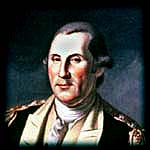Page content

Colonial Williamsburg Foundation
George Washington
George Washington in Williamsburg
In Williamsburg, seat of Virginia's government, George Washington
- Secured his first military commission
- Learned the art and mystery of politics
- Became leader of a continental revolution
Early visit
The tall figure of George Washington on horseback, his large, strong hands on the reins, was well known in Williamsburg for three decades. Washington may have known Williamsburg as early as 1749 when, as a 17-year-old, he may have visited his colony's capital to apply for a surveyor's license from the College of William & Mary.
More than 30 years later – in the autumn of 1781 – he again rode into town, this time as commander in chief of the American army.
Political and social life
In 1759, 27-year-old George Washington took a seat in the House of Burgesses in the Capitol and helped shape the idea of self-government for the next 16 years. He dined with such locals as George Wythe and Peyton Randolph. He worshipped at Bruton Parish Church. He enjoyed congenial evenings at the Raleigh, King's Arms, and Christiana Campbell's taverns. He attended the theater and once viewed four performances in a row, to see a particular red-haired actress deliver her lines. He supped with the governor and attended balls at the Palace and the Capitol. He patronized Williamsburg's tradesmen.
Family life
After his marriage to the widow Martha Dandridge Custis, Washington spent his honeymoon in Williamsburg. He sometimes brought his two beloved stepchildren with him to town. Washington administered the Custis estate in and around Williamsburg until Martha's son, John Parke Custis, came of age. The Custis estate included a large brick house on a square near the Public Hospital, three lots and houses on Duke of Gloucester Street opposite Bruton Parish Church, and a plantation in York County on Queen's Street.
Washington’s home at Mount Vernon was 160 miles, or four day's journey, from the capital, so Washington rented out most of the Williamsburg property during his trusteeship.
Early military life
For Washington the military officer, Williamsburg was headquarters. In January 1754, he made his way back to the capital from a hazardous trip deep into the Ohio country, where in vain he had warned French troops and trappers off British soil. Later, he returned as a survivor of the carnage at Braddock's defeat.
Gaining political influence
For Washington the legislator, Williamsburg was a proving ground. He was an intimate of every political leader of the colony during his years as a Virginia legislator. He introduced the Nonimportation Agreement in 1769 and in 1774 was sent by his fellow lawmakers as one of Virginia's seven delegates to the first Continental Congress.
General Washington
For Washington the general, Williamsburg was a staging point before victory at Yorktown. From his headquarters at the George Wythe House, he dispatched pleas for reinforcements, blankets, bread, clothing, ammunition, horses, and rum. September 27, 1781, Washington issued the general orders for the advance on British General Cornwallis at Yorktown. Within three weeks, the British surrendered their positions and their arms to American and French forces.
For further reading, see the biography of George Washington or excerpts from Duel in the Wilderness, written by Karin Clafford Farley (a children's book based on George Washington's own diary, published by The Colonial Williamsburg Foundation, Williamsburg, Virginia).
For further reading:
